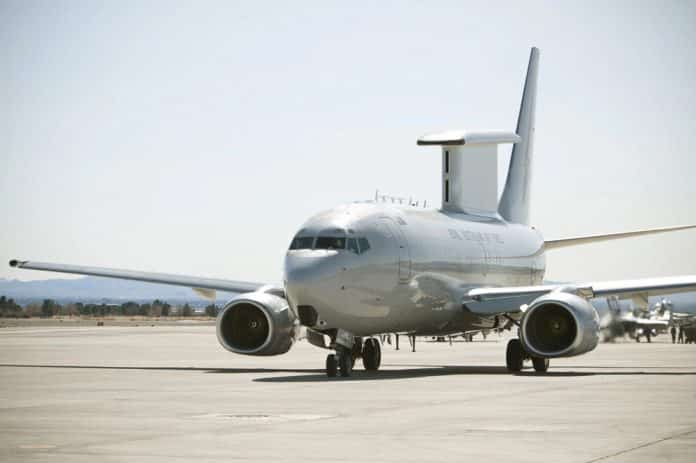In a statement released by the UK Ministry of Defence (MoD) 22 March, UK Defence Secretary Gavin Williamson has signed a $1.98Bn deal to purchase five E-7 airborne early warning and control (AEW&C) aircraft.
Designed for the Royal Australian Air Force (RAAF) under “Project Wedgetail” and designated E-7A Wedgetail, the E-7 is based on a standard Boeing 737 NG airliner modified to carry a sophisticated Northrop Grumman active electronically-scanned radar and will replace the UK’s ageing fleet of E-3 Sentry aircraft.
Defence Secretary Gavin Williamson said: “E-7 provides a technological edge in an increasingly complex battlespace, allowing our ships and aircraft to track and target adversaries more effectively than ever. This deal also strengthens our vital military partnership with Australia. We will operate state-of-the-art F-35 jets and world-class Type-26 warships, and this announcement will help us work even more closely together to tackle the global threats we face.”
Chief of the Air Staff, Air Chief Marshal Sir Stephen Hillier, said: “Today’s announcement about the procurement of five E-7 ‘Wedgetail’ Airborne Early Warning and Control aircraft is excellent news for both the RAF and wider Defence. This world-class capability, already proven with our Royal Australian Air Force partners, will significantly enhance our ability to deliver decisive airborne command and control and builds on the reputation of our E3D Sentry Force. Along with Defence’s investment in other cutting-edge aircraft, E-7 will form a core element of the Next Generation Air Force, able to overcome both current and future complex threats.”
The E-7 aircraft is currently in service with the RAAF, Turkish Airforce, Republic of Korea Airforce and has been used on operations in the fight against so-called Islamic State in Iraq and Syria.
This announcement builds on a growing military capability and industrial relationship between the UK and Australia after the Australian government selected the British Type 26 design for the Royal Australian Navy under the SEA 5000 (Future Frigate) programme.
E-7A
Type: Airborne Early Warning & Control (AEW&C) aircraft
Manufacturer: Boeing Defense, Space & Security, Boeing Commercial Airplanes
Country of Origin: United States
Operators: Royal Australian Air Force, Turkish Air Force, Republic of Korea Air Force
First Flight: 2005 | Introduction: 2009
Number Built: 14
Crew: Pilot, co-pilot and airborne electronics analysts and mission specialists
Weight: 77,565 kg (maximum take-off weight), 60,782 kg (maximum landing weight) | Length: 33.06 m | Wingspan: 35.8 m | Height: 12.5 m
On-board Systems: Multi-role electronically scanned array (MESA) radar with a range in excess of 400km; Electronic warfare self-protection measures including directed infra-red counter-measures, chaff and flares; Communication systems including HF, VHF, UHF, Link-11, Link-16, UHF SATCOM and ICS; 10 mission consoles
Engine: 2 × CFM International CFM56-7 turbofans (118.4kN (27,300lb) thrust each)
Cruise Speed: 530 mph (853 km/h)
Range: 3,500 nmi (6,500 km)
Ceiling: 41,000 ft

